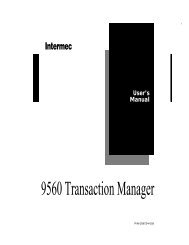Contents, cont'd. - Intermec
Contents, cont'd. - Intermec
Contents, cont'd. - Intermec
Create successful ePaper yourself
Turn your PDF publications into a flip-book with our unique Google optimized e-Paper software.
LAYOUT INPUT<br />
Chapter 2 Program Instructions<br />
Field of Application Statement for starting the recording of a layout description (<strong>Intermec</strong><br />
Direct Protocol only).<br />
Syntax LAYOUT INPUT <br />
is the desired name of the layout (max. 30 characters)<br />
including name of the device where the layout is to be stored.<br />
Remarks This statement can only be used in the <strong>Intermec</strong> Direct Protocol and starts the<br />
recording of a layout. All formatting instructions, such as PRPOS, MAG,<br />
FONT, BARFONT, BARSET, PRTXT, PRBAR, PRIMAGE, PRBOX,<br />
PRLINE etc., which are transmitted to the printer on the std IN channel after<br />
a LAYOUT INPUT statement and before a LAYOUT END statement, will<br />
be included in the layout.<br />
Due to inherent restrictions in Flash memories, layouts cannot be created in<br />
"c:" (which by default is the current directory), but must be created in the<br />
printer's temporary memory ("tmp:"), or possibly in an SRAM card ("card1:").<br />
Once a layout has been created in the temporary memory ("tmp:"), it can be<br />
copied to either "c:" or "card1:" so it will not be lost at power-off or reboot.<br />
Variable input data to text, bar code and image fields (PRTXT, PRBAR,<br />
PRIMAGE) can be provided separately by means of a LAYOUT RUN<br />
statement. Such variable data are indicated in the layout by string variables<br />
VARn$ where “n” is the number of the field in the LAYOUT RUN string<br />
of data.<br />
For example, the statement PRTXT "Hello" in the layout results in a fixed<br />
text, whereas the statement PRTXT VAR1$ results in a variable text, which<br />
is provided by the first field in a LAYOUT RUN string.<br />
The layout must not contain any PRINTFEED statements.<br />
The layout will not be saved until a LAYOUT END statement is executed.<br />
Example This example illustrates how the <strong>Intermec</strong> Direct Protocol is enabled, how<br />
new separators are specified, how a layout is stored in the printer's temorary<br />
memory, how variable data are combined with the layout, and how a label<br />
is printed. Finally, the <strong>Intermec</strong> Direct Protocol is disabled:<br />
INPUT ON ↵<br />
FORMAT INPUT "#","@","&" ↵<br />
LAYOUT INPUT "tmp:LABEL1" ↵<br />
FT "Swiss 721 BT"↵<br />
PP 100,250 ↵<br />
PT VAR1$ ↵<br />
PP 100,200 ↵<br />
PT VAR2$ ↵<br />
LAYOUT END ↵<br />
LAYOUT RUN "tmp:LABEL1" ↵<br />
#Line number 1&Line number 2&@ ↵<br />
PF ↵<br />
INPUT OFF ↵<br />
<strong>Intermec</strong> Fingerprint 7.2 – Reference Manual Ed. 3 127
















